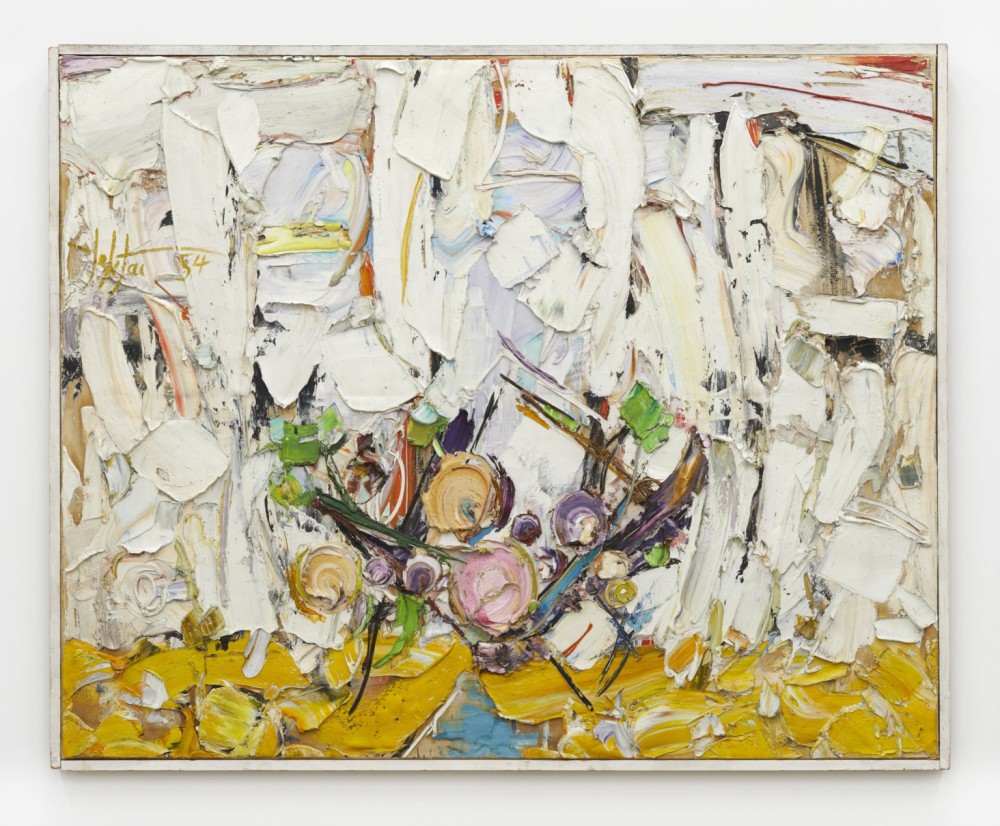
Manoucher Yektai: Beginnings
Artist-poet Manoucher Yektai painted relentlessly both before and after his rise as a member of the New York School, producing an immense oeuvre in dialogue with both the European and American avant-gardes and the academic tradition in which he was trained. Curated by Negar Azimi, this survey of his output between 1948 and 1969 is the most expansive presentation to date of his early work and the first time many of these paintings have been seen by the public. During these two decades, Yektai engaged with a wide variety of postwar art movements and Beaux-Arts traditions, experimenting with Surrealist-inflected abstractions, Abstract Expressionist still lifes, Minimalistic color studies, and heavily-impastoed portraits, among others. All the while, he never strayed from his early formalism, remaining concerned with color, gesture, and the construction of space within the canvas. Together, these works reveal a fuller picture of Yektai’s restless, singular vision.
The earliest paintings in the exhibition evince the importance of Yektai’s time in Paris in 1946 and ’47 on the development of his practice in New York. After studying at Tehran’s Fine Art Academy, a twenty-five-year-old Yektai made his way to the École des Beaux-Arts, ending up in Cubist André Lhote’s class. While he found the art scene stale and soon settled in New York, the Surrealist works he saw in Paris likely informed the three untitled paintings from 1948 and ’49 on view here. Rendered in a palette of blues and browns unique to this period, organic forms redolent of those of Joan Miró and Jean Arp follow horizontal and vertical axes to create what art historian Hamed Yousefi describes as “melting dreamscapes” in the exhibition catalogue. Of special interest is a kite-shaped work from 1949: Untitled predates by almost two decades the emergence of shaped canvases by other artists, notably Frank Stella and Ellsworth Kelly, in the 1960s. Born from an originary place of abstraction, this work’s gestures toward representation anticipate Yektai’s mature experimentations with genre and formalism.
A fateful encounter with Jackson Pollock in the pages of TIME in 1949 radically altered Yektai’s trajectory. Spurred by Pollock’s unconventional manner of getting paint on canvas, Yektai began applying oil straight from the tube to the surface, moving it across his canvases using trowels and palette knives. Two paintings from 1950 on view here represent some of his earliest uses of impasto. While the horizontal and vertical structures of earlier surrealistic works remain present, contoured shapes have been replaced by visceral rectangles of color. These gridded paintings represent the last moment of pure abstraction in Yektai’s oeuvre: in the ensuing years, he would return to his roots in the Beaux-Arts tradition and begin working primarily across the genres of portraiture, still life, and landscape. Rather than using an easel or hanging his canvases on the wall, he worked on the floor, standing above his supports as he pushed paint into place. Still Life with Flowers (1952) sees Yektai embracing, for the first time, the dramatic effect of impasto against unpainted ground as he constructs a just-barely representational scene from thick, discrete daubs of oil. Untitled (1953) extends even further into three-dimensions, its swirls of paint verging on the sculptural, while in Yellow Curtain (1954), his strokes slash rhythmically across the canvas like Xs.
Yektai’s portraits obscure the identities of his sitters to various degrees, using the human form as a launching point for the exploration of how paint performs. Head and Head of a Woman (both 1953) achieve maximum representational capacity from minimal means. Yektai defines the planes of these visages with two large, confident strokes that imply shadow and roundedness without any shading. Discussing these and other portraits by the artist in 1961, critic Robert Pincus-Witten praised Yektai’s tendency to “kill the sitter,” defacing their identity through his “bravura style” of “gesture and rapidity.” For Pincus-Witten, Yektai’s contribution to the tradition of society painting is his disavowal of the portrait as a vehicle for conveying class. Yektai continued throughout this decade to make radical representations of the figure alongside more traditional depictions of patrons and other high-society folk. In Portrait of Isa, the artist’s exclusive use of dark-valued colors to render his model’s body, face, and clothing makes it nearly impossible to distinguish her features. “It’s so bright, all this brightness,” is written in calligraphic Farsi within the composition, the words hanging in the white expanse that sets off the inky figure.
Throughout the 1960s, Yektai increasingly probed the negative space or “brightness” that he first began to explore in the early 1950s. Mining the subtleties of white that had fascinated him for decades, he reduced his number of strokes per painting, allowing his forms to pop against raw expanses of canvas. In an untitled painting from 1963, Yektai uses shades from silvery to off-white to subtly imply, without describing, the surroundings of his subject. The cigar box—one of many that the artist saved after smoking its contents and filled with ephemera—emerges from the surface like whitecapped waves. In a rare diptych from 1965, Yektai carves out a tablescape from white paint on white canvas, creating a textured monochrome that conjures associations with the minimalism of Robert Ryman. By 1969, the date of the latest painting in this exhibition, any indication of real space had dropped away. Bowls of fruit float in undefined expanses as drifting in some luminous sea.
The end of this show’s timeline was only the beginning of a new phase for the artist, who would continue to create until his death in 2019. In 1970, his epic poem Falgoosh—titled after a Persian tradition of eavesdropping in the service of divination—was published in Iran, marking Yektai’s greatest achievement to date in his other chosen art form. Like his paintings and his cigar boxes, Falgoosh scavenges fragments of narrative and genre and recombines them into a transformed reflection of the sights of everyday life, entwining disparate strands into a saga that we have only just begun to understand.